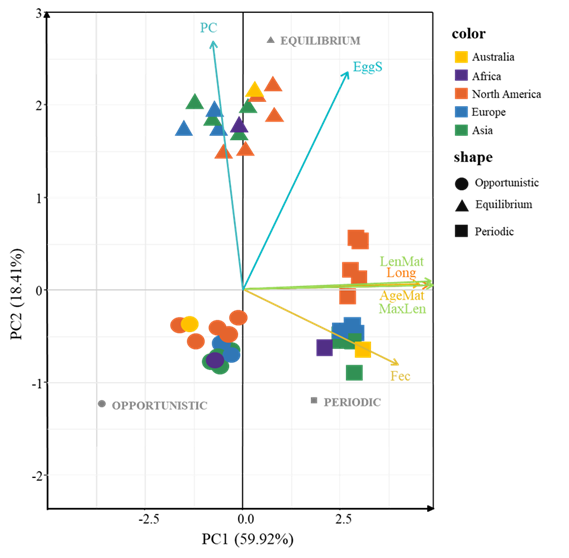What environmental factors determine fish life history strategies in a river?
Published 18 July, 2025
How do fish respond to changing hydrological and climatic conditions? This question lies at the core of ecological research. Previous studies have shown that life history traits in fish represent adaptive evolutionary responses shaped by long-term natural selection, and the life history theory offers a theoretical framework for understanding how environmental changes influence the composition and distribution of fish communities.
Recently, a multinational research team compiled life history trait data for 1,613 fish species across 14 major rivers worldwide. Their analysis revealed significant variation in the proportion of opportunistic, periodic, and equilibrium strategies among river systems. These differences were strongly associated with key environmental variables, including mean annual temperature, annual precipitation, annual variation in river discharge, and latitude.
“We found that opportunistic strategists are better adapted to warm, precipitation-rich rivers with high hydrological variability, whereas periodic strategists tend to thrive in systems with more predictable flow regimes,” explained Lan Zhu, lead author of the study published in Water Biology and Security.
In addition, the researchers conducted a molecular phylogenetic analysis of 230 fish species from the Yangtze River to reconstruct the evolutionary history of their life history strategies.
“The results showed that before the Paleocene, it was dominated by periodic strategists,” shares Zhu. “However, since the prevalence of a monsoon climate and the overall alteration of precipitation patterns in the Miocene, the proportion of opportunistic strategists increased, suggesting a life history shift driven by climate-induced environmental instability.”
The team’s not only reveals the evolutionary pattern of life history strategies of Yangtze fishes, but also provides a theoretical foundation for ecological monitoring and management of riverine ecosystems in the future.

Contact author name:
Lan Zhu, State Key Laboratory of Breeding Biotechnology and Sustainable Aquaculture, Institute of Hydrobiology, Chinese Academy of Sciences, zhulan@ihb.ac.cn.
Funder:
The Science & Technology Fundamental Resources Investigation Program (Grant number 2022FY100400)
The research program of China Three Gorges Corporation (201903144)
The National Natural Science Foundation of China (32473167)
Conflict of interest:
Huanzhang Liu and Martin Reichard are editorial board members of Water Biology and Security and were not involved in the editorial review or decision to publish this article. The authors declare that they have no known competing financial interests or personal relationships that could have appeared to influence the work reported in this paper.
See the article:
Lan Zhu et al., 2025, Key environmental factors determining life history strategies of river fishes and their historical changes in the Yangtze River. Water Biology and Security, 4(1), 100376. DOI 10.1016/j.watbs.2025.100376